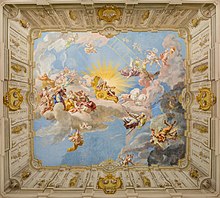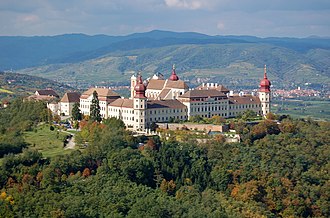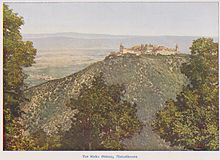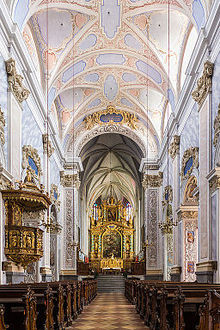Göttweig Abbey
| Göttweig Abbey | |
|---|---|
 Coat of arms of Göttweig Abbey |
|
| location |
|
| Lies in the diocese | St. Polten |
| Coordinates: | 48 ° 22 '4 " N , 15 ° 36' 45" E |
The Göttweig Abbey (formerly: Köttwein ) is a Benedictine monastery of the Austrian Benedictine Congregation . It is located in the municipality of Furth near Krems in Lower Austria on a hill south of the Danube at the foothills of the Dunkelsteinerwald .
In 2000 it was included in the list of UNESCO World Heritage Sites as part of the “ Wachau cultural landscape with the Melk and Göttweig monasteries and the old town of Krems” .
history

First settlement until the monastery was founded in 1083
The Göttweiger Berg was from around 2000 BC. Settled, which can be reconstructed through small finds in the area of today's monastery - from the Neolithic to the Roman era. The settlement continuity was probably interrupted from the 3rd to the 9th century. The consecration of a first church (in honor of St. Erentrudis ) is documented for the year 1072 . The deed of foundation with which St. Bishop Altmann von Passau established the canon monastery is dated September 9, 1083. In it, the monastery is assigned a number of parishes, including Kilb , Nalb , Pfaffendorf , Mühlbach am Manhartsberg and Pyhra . The pastoral care associated with this also remained under the Benedictines, to whom the monastery was given in 1094 under Bishop Ulrich I of Passau . These first monks came with Abbot Hartmann I from the St. Blasien monastery in the Black Forest ; their reform impulses were at the beginning of the 12th century from Göttweig to the monastery Seitenstetten and - with the blessed Wirnto and St. Berthold - carried on to Garsten Abbey (1107–1783) and subsequently to Vornbach Abbey (before 1108–1803).
12th to 17th centuries: buildings and sieges
From the first building epoch in the 12th century only the nave of the church, the Erentrudis chapel and the "castle" are preserved, from the late Gothic building epoch of the 15th century the choir of the collegiate church with crypt and sacristies and wings of the cloister (today lapidarium ) . The Georgskirche on Göttweigberg also existed until the first Turkish siege , the foundation walls of which were uncovered during excavations in 2009 together with some eaves burials .
In 1401 the monastery received the exemption privilege , which was renewed in 1452 and 1498 after objections by the Passau bishops . The late 15th and early 16th centuries were marked by economic and personnel decline, exacerbated by the Turkish threat and the Reformation , so that from 1556 to 1564 the monastery was only managed by an administrator and the abbot Michael , who was elected in 1564, from the Melk Abbey Had to start wonderfully without conventuals . Despite the major fire in 1580 and the plague epidemic in 1596, he was able to leave his successor in 1604 in order. The impact of Abbot Georg Falb (1612–1631) in the founding of the Austrian Benedictine Congregation and for the Counter-Reformation as well as that of his successor Abbot Gregor I. Cornerus (1631–1648) went far beyond the monastery boundaries, among other things through the publication of the first German-speaking Catholic hymn book "Groß Catholisch Gesangbuch".
Extensive building activity began in the 18th century
After the fire of 1718 under Abbot Gottfried Bessel (1714–1749), the new building of the monastery according to plans by Johann Lucas von Hildebrandt proceeded rapidly in the first years, then more and more slowly, until it was completely stopped after 1750 (construction of the church facade). so that only about two thirds of the construction plan were implemented. Bessel also emerged as a historian, diplomat and patron of the arts and rector of the University of Vienna .
The Josephine reforms in 1783 brought about an increase in pastoral care positions from 20 to 31, mainly through division. Among the scientists of the 19th and early 20th centuries are Friedrich Blumberger (historian), Lambert Karner (“cave pastor”), Leopold Hacker (entomologist), Willibald Leeb (legend researcher), Benedikt Kissling (botanist) and the abbots Adalbert Dungel and Adalbert Fuchs, both historians, should be mentioned.
20th century
In 1939, the pen in favor of the independent city was Krems expropriated and the Convention after a short detention in Unternalb konfiniert . The monastery building now served as a resettlement camp, prisoner of war camp and from 1943 to 1945 as an educational institution for national politics , before it was devastated at the end of the war and became barracks for the Soviet occupation forces . After the return of the convent in August 1945 and the death of Abbot Hartmann Strohsacker (1930–1946), the monastery was threatened with annulment because it was no longer considered viable due to a lack of admissions and after the numerous deaths during and after the war years. Abbot Wilhelm Zedinek (1949–1971) carried the main burden of restitution and reconstruction. From 1973 to 2009 the monastery was headed by Abbot Clemens Lashofer. During his term of office, a gradual restoration took place, the establishment of the retreat house St. Altmann (1983) and (after the closure of the Choir Boys Institute) that of the youth center (1999).
Monasteries connected to Göttweig Abbey
The Benedictine monastery founded in Kleinwien was probably relocated to the Stiftsberg around 1200 and set up on the south-west hilltop, around today's Erentrudis chapel. In 1557 the already reduced nunnery moved to St. Bernhard bei Horn .
In 1715 the Göttweig Abbey received the Zalavár (Moosburg) Abbey in Hungary , which was destroyed in the Turkish Wars, as a subsidiary abbey. The new monastery was built in Zalaapáti . Until 1872 the monastery was partly managed by branch abbots and partly by the Göttweiger abbot.
In 1974 the dependent house Sankt Josef was built as domus formata in Maria Roggendorf's parsonage . In 1986 it became a superior, in 1991 a dependent and - after the monastery building was expanded in 1995 - an independent priory in 2005 .
description
Due to its location on a hill, Göttweig Abbey is known as the Austrian Montecassino .
Overview
Most of the buildings were erected after the fire of 1718 and have the shape of a grating, based on the model of the Escorial . Of the four planned corner towers of the ideal plan, only three were built: the Sebastianiturm in the northwest, the Frauenturm in the northeast and the Altmanniturm in the southeast. In the main axis (east-west axis) are the collegiate church, the chapter house (today the choir chapel) and the library; the ballroom to the west was planned, but not implemented. Most of the monk cells are in the east wing. A large part of the north wing up to the Kaiserstiege is taken up by the museum in the Kaisertrakt as well as the archive and the two refectories . The administration and youth center are located in the south wing. The outer building in the west serves as a retreat house. The older components in the south-west of the monastery complex do not go back to Hildebrandt's plan: the "castle" and the Erentrudis chapel as well as the farm buildings behind it, which were only built in 1911.
Collegiate church
The core of the collegiate church in the nave is Romanesque (from the time the monastery was built, a porch from the 11th century is proven). The reconstruction of the Romanesque complex showed a kink in the axis , whereby the axis of the choir may be oriented towards the sunrise on the 4th Sunday of Lent in 1072 (then March 18th), the nave on the previous Tuesday, March 13th 1072. The one above the crypt The elevated early Gothic presbytery was built between 1401 and 1430. In the 17th century and - according to a plan by Johann Lukas von Hildebrandt to redesign the facade from the first third of the 18th century - the church was largely redesigned in Baroque style. The stucco work (1665 to 1681) was made by Northern Italian masters.
The high altar picture of the Assumption of the Virgin Mary (1694) is by Andreas Wolff ; the high altar (with statues of St. Peter , Paul , Gregor , Altmann, Katharina , Barbara and the mother of God Maria ), which forms an ensemble with the pulpit and parts of the organ front , by Hermann Schmidt (1639). The inlaid choir stalls were made by Franz Staudinger in 1766; the two imperial chairs (used today as ambo ) may have been made in the same workshop a little earlier.
In the eight side chapels of the nave are u. a. two altar leaves by Martin Johann Schmidt can be seen (Altmann altar and Benediktus altar in the southern row of chapels).
In the summer sacristy, attached to the south of the presbytery, there is the former high altar of the collegiate church and in the treasury there are paraments and liturgical implements , including special features such as a Gothic pigeon , an Art Nouveau chalice and baroque leather chasubles .
The original entrance to the collegiate church led through a south portal (with an inscription and niche Madonna from 1668), which was walled up in the 18th century and reopened in 2010 when barrier-free access was built. The double tower facade was only built between 1750 and 1755; the spiers were not implemented, so the temporary blunt church tower tent roofs remained.
crypt
In the main crypt under the presbytery of the collegiate church, on the altar of grace ( Empire period 1804), there is the Göttweiger Pietà , a wooden sculpture from the mid-15th century, reworked in 1880. The pilgrimage tradition, interrupted in 1784, was resumed in 1988. In the southern crypt room ("Altmanni-Krypta") is the Altmanni-Shrine, a reliquary made in 1668 with silver filigree decoration and the relics of the saint, an epitaph made in 1540 by Konrad Osterer with a reclining figure of St. Altmann. The ceiling painting by Kremser Schmidt , Ezekiel's vision , fits thematically to the convent crypt from 1638 below. The path leads through the northern crypt room (baptistery and confessional chapel) to the Gothic cloister wing, which has been preserved and is furnished as a lapidarium, and the like. a. with a sandstone lion from the late 12th century as well as memorial and grave epitaphs. Further abbot epitaphs are located in the church porch.
Erentrudiskapelle
The foundations of the freestanding chapel in the southwest of the monastery courtyard probably go back to the Erentrudiskirche, consecrated in 1072, and dates back to the construction period of the 12th century, but today it is Gothic . It was the center of the nunnery until 1557 and later carried the Called Sebastianikapelle , after it was profaned, it was rebuilt and built in, released again in 1910/11, revised, rededicated, and last renovated in 2003.
"Castle"
The core of the building in the south of the monastery courtyard, known as the castle, dates back to the 12th century. The western half of the building, which was originally surrounded by four massive round towers and a moat, is still preserved. The building was originally used for defense purposes, later for workshops and apartments, then as a monastery gate. In 2001/02 it was extensively renovated, houses the graphic collection and is also used by the Center for Image Studies at Danube University Krems .
Museum in the imperial wing

The Kaiserstiege in the north-west of the monastery courtyard rises over three floors and was provided with a ceiling fresco by Paul Troger in 1739 , depicting Emperor Karl VI in its center . shows as Helios-Apollo with the muses . The figural equipment with statues of the seasons, monthly vases and artist busts comes from Johannes Schmidt , the father of Kremser Schmidt. The adjoining prince and imperial rooms - most of them with remarkable wallpaper paintings - serve as museum rooms, as does the Altmanni Hall with the ceiling fresco Wedding at Cana by Johann Rudolf Byß and Johann Baptist Byß. In addition to the basic inventory, the museum shows annually changing special exhibitions - mainly with objects from the Göttweig collections:
- 2000 Anno Salutis 2000. The healing power of Christianity
- 2001 Göttweig & Kremser Schmidt
- 2002 Göttweiger views. Graphics - paintings - handicrafts
- 2003 Under the guidance of the Gospel
- 2005 "Under your protection ..." The image of Mary in Göttweig (1st part)
- 2006 "Under your protection ..." The image of Mary in Göttweig (2nd part)
- 2007 Festive gifts made of wax
- 2008 Heiliger Altmann - 925 years of Göttweig Abbey
- 2009 120 masterpieces (from the graphic collection) / Handel-Haydn-Mendelssohn (from the music archive)
- 2010 120 masterpieces (from the graphic collection) / Handel-Haydn-Mendelssohn (from the music archive) - continued
- 2011 Beautiful Wachau: World cultural heritage in pictures from Biedermeier to modern times
- 2012 Austria's glory in the Troger sky. The Göttweiger Kaiserstiege
- 2013 Austria's glory in the Troger sky. The Göttweiger Kaiserstiege - continued
- 2014 Large graphic in Göttweig
- 2015 "950 Years of Bishop Altmann" and "Iconographic Riddles"
- 2016 Holy Year 2016 - Pilgrimage to Rome
- 2017 Maria Theresia - Visiting Göttweig Abbey
- 2018 "Stift Göttweig burns - fateful year 1718" and "Luther in Göttweig - Part II"
- 2019 Göttweig Abbey as a defense structure - fortified and defended in the storm of times
- 2020 Archeology in Göttweig: OLD Walls - NEW Insights
Collections
The graphic collection has about 30,000 sheets - after the Vienna Albertina - the second largest graphic collection in Austria. The first news comes from an inventory from 1612 - Abbot Georg Schedler had some “copper engraving panels” purchased as wall decorations. In the 17th century the collection grew slowly; Abbot Gottfried Bessel, who was aiming for a comprehensive collection of graphics, acquired more than 20,000 sheets; P. Vinzenz Werl (1810–1861) rearranged the collection and in 1843 wrote the two-volume catalog. Most of the graphics come from the Baroque period with works by German, Dutch, Italian, French and English masters; Its broad thematic spectrum ranges from devotional images and images of saints, portraits of rulers and mythological subjects to architecture and ornaments that were used after the fire of 1718 as models for the architecture and furnishings of the new building. The establishment of the Graphisches Kabinett primarily pursued pedagogical and didactic purposes: The graphics were intended to help the conventuals develop their tastes and as a study and template for artists. The collection has been digitally indexed by the Department of Image Sciences at Danube University since 2002 and has also been accessible via the Internet since 2006.
The library comprises around 140,000 volumes, around 44,500 of which are located in the baroque library room , which is a - comparatively simple - work space in the central projection of the east wing and thus in the enclosure . As it is not accessible as part of general tours, representative works are exhibited in the museum in the imperial wing.
The same applies to the exhibits in the art collection (following the baroque “Chamber of Art and Wonder”), the numismatic collection , the archive and the music archive .
Duties of the Göttweiger Benedictines
The abbey has 41 monks - after a founding convention was sent to Maria Roggendorf. The main task is parish pastoral care, especially in the 28 incorporated parishes. In the Archdiocese of Vienna are: Jetzelsdorf , Maria Roggendorf, Nappersdorf , Pfaffendorf, Ober- and Unteralb ; in the diocese of St. Pölten : Brunnkirchen, Furth, Gansbach , Getzersdorf , Grünau , Haindorf , Hainfeld , Kilb , Kleinzell , Kottes , Markersdorf , Mauer , Mautern , Paudorf-Göttweig , Purk , Pyhra, Rabenstein , Rohrbach , Rossatz , St. Veit , Schwarzenbach and Unterbergern . Further tasks lie in the categorical pastoral care in the youth center and in the retreat house (both in the monastery), in school, hospital and prison as well as in scientific work and internal functions.
The choir prayer is open to the public (Easter to All Saints' Day at noon and in the evening in the church); the Vesper is on Sundays, high-strength and festivals latin (in plainsong celebrated).
The economic basis of the monastery is formed by forestry (with hunting and fishing leases , the "Göttweiger forest adventure world" near the sequoia trees ), viticulture (leased), tourism (with a restaurant and event service in the fountain hall and summer refectory) and, to a lesser extent, agriculture .
Abbey parish churches
- 1080/1516 Parish Church Kilb
- 1110/1323/1332 parish church Hofstetten-Grünau
- 1112 Parish and pilgrimage church of Mauer near Melk
- 1161 Hainfeld parish church
- 1330 Kleinzeller parish church
- ? Furth parish church near Göttweig
Abbots of Göttweig
|
|
Events
Since 1995 the monastery has been the venue of the European Forum Wachau , which is organized by the Foreign Ministry and the Lower Austrian provincial government .
Since 2007, a concert has been held annually under the motto classical under the stars . Well-known artists such as the opera singer Elīna Garanča or the conductor Karel Mark Chichon appear.
literature
- Heinrich Siegl: The Göttweig Benedictine Monastery , Göttweig, 1914
- Adalbert Fuchs : The Göttweig Benedictine Abbey. Its founding and legal relationships in the Middle Ages , Salzburg, 1917
- Ludwig Koller: Göttweig Abbey, outline of its history and cultural work , Horn, 1953
- Gregor M. Lechner: Göttweig Abbey and its art treasures , St. Pölten, 1977
- History of the Göttweig Abbey 1083–1983. Commemorative publication for the 900 year anniversary . EOS-Verlag, St. Ottilien 1983 (studies and communications on the history of the Benedictine order and its branches, vol. 94, items I – II)
- 900 years of Göttweig Abbey 1083-1983. A Danube pen as a representative of Benedictine culture, catalog for the anniversary exhibition , Göttweig Abbey, self-published, 1983
- Clemens Anton Lashofer: Profess book of the Benedictine monastery Göttweig . EOS-Verlag, St. Ottilien 1983 (studies and communications on the history of the Benedictine order and its branches, vol. 26)
- The Göttweig Benedictine Abbey in the Wachau and its collections , (Text: Gregor Martin Lechner; Photos: Friedrich Brunner, Author: Lechner, Gregor Martin; Brunner, Friedrich), Munich a. a. : Schnell & Steiner, 1988, ISBN 3-7954-0677-3
- Gregor Martin Lechner : Göttweig . In: Ulrich Faust, Waltraud Krassnig (ed.): The Benedictine monastery and nunnery in Austria and South Tyrol . EOS-Verlag, St. Ottilien 2000 (Germania Benedictina, III / 1), pp. 768-843, ISBN 3-8306-7029-X .
- Gregor M. Lechner: The Benedictine monastery Göttweig . Regensburg: Schnell & Steiner 2008 (Schnell & Steiner Großer Kunstführer 153), ISBN 978-3-7954-2024-6
- 925 years of Göttweig Abbey - new research on the history of the Benedictine abbey. Symposium from August 8 to 10, 2008 . In: Studies and communications on the history of the Benedictine order and its branches, Vol. 120, 2009, pp. 321-541, ISSN 0303-4224
- Gregor M. Lechner, Michael Grünwald: “The Göttweig Abbey Graphical Collection. History and Masterpieces ”. Regensburg: Schnell & Steiner 2010 (Schnell & Steiner Großer Kunstführer 252), ISBN 978-3-7954-2343-8
- Peter Aichinger-Rosenberger: “Ecclesia beate mariae in monte kottwich. On the medieval building history of the Göttweig collegiate church - results of building research ”. University of Vienna, dissertation, 2011
- Castles, pens and chateaus in the Waldviertel, Danube region, South Bohemia, Vysočina, South Moravia regions. ISBN 978-3-9502262-2-5 , p. 36 ff
- Göttweig Abbey. Well thought out. (Preservation of monuments in Lower Austria, Volume 59). Ed. Office of the Lower Austrian State Government Department of Art and Culture, St. Pölten 2018.
Web links
- Göttweig Abbey - Homepage
- Entry for Göttweig Abbey in the State Memory of the History of the State of Lower Austria ( Museum Niederösterreich )
- Göttweig Abbey Youth Center
- Graphic collection online
- Fund: Documents (1058-1899) (Göttweig Abbey) in the European document archive Monasterium.net .
- Photo gallery of Göttweig Abbey
Individual evidence
- ↑ Traces of St. George's Church on Göttweiger Berg on ORF Lower Austria from February 8, 2010, accessed on February 8, 2010.
- ^ Archaeological research on the Göttweiger Predigtstuhl Monument of the Month 2/2010 of the Federal Monuments Office, accessed on February 11, 2010
- ^ Erwin Reidinger: Orientation of medieval churches . In: Office of the Lower Austrian State Government (Ed.): Gestalte (n). The magazine for building, architecture and design . N ° 139, March 2013, p. 47 ( noe-gestalten.at [accessed on April 26, 2017]). ZDB ID 2708987-3
- ↑ Entry on the Göttweig collegiate church in the database of the state's memory of the history of Lower Austria ( Museum Niederösterreich )
- ↑ Klassik unter Sternen 2009-2011, accessed on November 22, 2011










